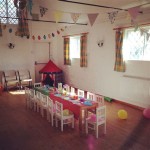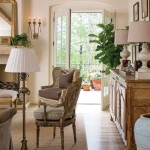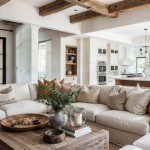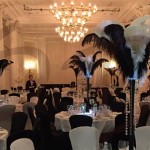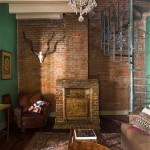How to Decorate With Mirrors In Dining Room
Mirrors, often regarded as mere functional objects, possess the remarkable ability to transform a dining room from a simple space used for meals into a captivating and visually expansive environment. Their reflective properties make them potent tools for enhancing natural light, creating illusions of greater square footage, and adding a touch of sophistication to any interior design scheme. Strategically incorporating mirrors into a dining room can dramatically alter the perception of the room, making it feel brighter, more spacious, and more stylish.
Before embarking on the process of decorating with mirrors, careful consideration should be given to the room's existing layout, lighting conditions, and overall design aesthetic. Understanding these factors will inform the selection of appropriate mirror types, sizes, and placement strategies. A poorly chosen or positioned mirror can detract from the overall ambiance, highlighting undesirable features or creating awkward reflections. Conversely, a well-placed mirror can become a focal point, enhancing the room's best attributes and creating a harmonious and inviting atmosphere.
The shape and size of the mirror are crucial considerations. A large, rectangular mirror can visually elongate a narrow dining room, while a round or oval mirror can soften the hard lines of a more angular space. Smaller, decorative mirrors can be grouped together to create a gallery wall effect, adding visual interest and texture. The frame, or lack thereof, also plays a significant role. A heavily ornate frame can add a touch of classic elegance, while a minimalist frameless mirror offers a more contemporary and understated look. The goal is to select mirrors that complement the existing decor and enhance the overall design vision.
Maximizing Natural Light and Space
One of the most significant benefits of using mirrors in a dining room is their ability to amplify natural light. Positioning a mirror opposite a window allows it to reflect and redistribute sunlight throughout the space, effectively doubling the amount of light and reducing the need for artificial illumination. This is particularly beneficial in dining rooms that receive limited natural light due to their orientation or proximity to other buildings. By strategically placing mirrors to capture and reflect existing light sources, a room can instantly feel brighter and more inviting.
Beyond increasing illumination, mirrors can also create the illusion of greater space. This is especially valuable in smaller dining rooms where maximizing visual square footage is essential. A large mirror placed along an entire wall can effectively double the perceived size of the room, creating a more open and airy feel. This technique is particularly effective when the mirror reflects a visually appealing element, such as a window with a view or a statement piece of furniture. The reflected image creates a sense of depth and expansion, making the room feel less confined.
When aiming to create an illusion of space, consider the surrounding elements. Avoid placing a mirror where it reflects a cluttered area or an unattractive view, as this will only amplify these undesirable aspects. Instead, focus on reflecting positive features and maintaining a well-organized and visually appealing environment. The mirror should enhance the existing aesthetic, not detract from it.
Strategic Placement and Reflection Considerations
The placement of mirrors is paramount to achieving the desired effect. Simply hanging a mirror without considering its surrounding environment can lead to disappointing results. Thoughtful consideration should be given to what the mirror will reflect, and how that reflection will contribute to the overall ambiance of the dining room. Avoid reflecting undesirable areas or clutter, and instead focus on capturing positive architectural features, natural light, or visually appealing decor.
A mirror positioned above a sideboard or console table can create a focal point and add visual height to the room. This placement is particularly effective when combined with decorative accessories, such as lamps, vases, or artwork. The mirror reflects these elements, creating a layered and visually rich display. Similarly, a mirror placed behind a dining table can visually extend the table and create a more inviting atmosphere for gatherings. This placement is particularly effective with round or oval tables, as the mirror reflects the curvature and enhances the sense of intimacy.
Consider the height at which the mirror is hung. A mirror hung too high can feel disconnected from the rest of the room, while a mirror hung too low can create an awkward and unbalanced look. The ideal height is typically eye level, allowing the mirror to reflect the viewer's face and create a sense of connection. However, the specific height may need to be adjusted based on the size and shape of the mirror, as well as the overall proportions of the room.
Selecting the Right Mirror Style and Frame
The style of the mirror should complement the overall design aesthetic of the dining room. A formal dining room may benefit from a mirror with an ornate frame and a classic design, while a contemporary dining room may be better suited to a minimalist frameless mirror or a mirror with a sleek metallic frame. The choice of frame should reflect the overall style of the room and enhance its existing decor.
Consider the materials used in the frame. Wood frames can add warmth and texture to a dining room, while metal frames can create a more modern and industrial look. Mirrored frames, also known as Venetian mirrors, can add a touch of glamour and sophistication. The choice of material should be based on the desired aesthetic and the existing materials used in the room. The color of the frame is also an important consideration. A neutral frame can blend seamlessly into the background, while a bold or contrasting frame can add a pop of color and visual interest.
Frameless mirrors offer a clean and contemporary look that is particularly well-suited to minimalist or modern dining rooms. These mirrors provide a seamless and unobtrusive reflection, allowing the focus to remain on the surrounding decor. Frameless mirrors are also a great option for smaller dining rooms, as they do not add any visual clutter or bulk. They can be hung individually or grouped together to create a larger, more impactful display.
The shape of the mirror can also contribute to the overall style of the dining room. Round or oval mirrors can soften the hard lines of a more angular space, while rectangular or square mirrors can add a sense of formality and structure. Irregularly shaped mirrors can add a touch of whimsy and personality. The key is to choose a shape that complements the existing architecture and decor of the room. Avoid using overly ornate or elaborate mirrors in smaller dining rooms, as they can overwhelm the space and create a cluttered feel. Instead, opt for simpler and more streamlined designs that enhance the sense of spaciousness.
Ultimately, the goal is to select mirrors that not only reflect light and create the illusion of space but also contribute to the overall aesthetic of the dining room. By carefully considering the size, shape, style, and placement of mirrors, it is possible to transform a dining room into a visually stunning and inviting space that reflects personal taste and enhances the dining experience.

How To Decorate Your Home With Mirrors In Some Stunning Ways World Inside S Mirror Dining Room Elegant Luxury

How To Decorate With Mirrors Decorating Ideas For
:strip_icc()/dining-room-mirror-ideas-1-ashley-montgomery-b90b98cab74443e9ab4f9d5e9f6ac2d2.jpeg?strip=all)
17 Dining Room Mirror Ideas That Ll Dress Up Your Walls

How To Use Wall Sconces Design Tips Ideas Mirror Dining Room Walls Decor

Transform Your Dining Room With A Mirror Decoholic

Dining Room Mirror Ideas Glass Genius

Decorating With Mirrors Modern Bedroom Decor Mirror Dining Room

10 Innovative Mirror Uses For Home Interior Design

Spice Up Your Dining Room With Mirrors

Interesting Ways To Decorate With Mirrors
Related Posts

